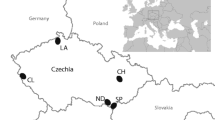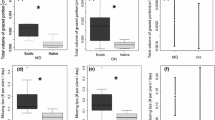Abstract
Studying density- (total available resources) and frequency-dependent (relative abundance of resources) foraging by herbivores can shed light on our understanding of insect–plant interaction. However, these concepts are rarely investigated on different resources within an individual plant, such as flowers and leaves, even though this can be informative on how each plant individual allocates different resources and defends against florivory and folivory. We performed manipulative experiments in an insectary on the facultatively florivorous grasshoppers (Xenocatantops humilis) and flowering twigs of the tropical dogwood (Mussaenda erythrophylla). The tropical dogwood was used because each plant has both typical leaves and modified calyx lobes of the flowers which function as attractive flags. By manipulating the densities and frequencies, in terms of biomass, of leaves and flag calyx lobes, we aimed to investigate the following questions: (1) Do the grasshoppers exhibit density- and/or frequency-dependent foraging of the intra-plant structures? (2) Do the grasshoppers show a dietary preference for the intra-plant structures? (3) Do relative and/or total biomasses of the intra-plant structures affect the intensity of corolla feeding? Our results provide support for frequency-, but not density-dependent foraging. We found that relative consumption and total herbivory increase with the relative biomass of the preferred flag calyx lobes, whereas a larger corolla diameter increases the intensity of corolla feeding. Our findings suggest that the colourful flag calyx lobes attract unwanted herbivores but could potentially be a decoy against folivory.






Similar content being viewed by others
References
Agrawal AA, Fishbein M (2006) Plant defence syndromes. Ecology 87:S132–S149
Andersson P, Löfstedt C, Hambäck PA (2013) Insect density–plant density relationships: a modified view of insect responses to resource concentrations. Oecologia 173:1333–1344
Armbruster WS (1997) Exaptations link evolution of plant–herbivore and plant–pollinator interactions: a phylogenetic inquiry. Ecology 78(6):1661–1672
Armbruster WS, Howard JJ, Clausen TP, Debevec EM, Loquvam JC, Matsuki M, Cerendolo B, Andel F (1997) Do biochemical exaptations link evolution of plant defence and pollination systems? Historical hypotheses and experimental tests with Dalechampia vines. Am Nat 149(3):461–484
Behmer ST, Raubenheimer D, Simpson SJ (2001) Frequency-dependent food selection in locusts: a geometric analysis of the role of nutrient balancing. Anim Behav 61(5):995–1005
Bergvall UA, Leimar O (2017) Directional associational plant defence from Red deer (Cervus elaphus) foraging decisions. Ecosphere 8(3):e01714
Bernays EA, Bright KL (1993) Mechanisms of dietary mixing in grasshoppers: a review. Comp Biochem Physiol A 104(1):125–131
Bernays EA, Chapman RF (1970) Experiments to determine the basis of food selection by Chorthippus parallelus (Zetterstedt) (Orthoptera: Acrididae) in the field. J Anim Ecol 39(3):761–776
Bernays EA, Chapman RF (1994) Behaviour: the process of host-plant selection. In: Bernays EA, Chapman RF (eds) Host-plant selection by phytophagous insects, pp. 95–165. Chapman and Hall, London
Bernays EA, Weiss MR (1996) Induced food preferences in caterpillars: the need to identify mechanisms. Entomol Exp Appl 78(1):1–8
Borges RM, Gowda V, Zacharias M (2003) Butterfly pollination and high-contrast visual signals in a low-density distylous plant. Oecologia 136(4):571–573
Brody AK, Mitchell RJ (1997) Effects of experimental manipulation of inflorescence size on pollination and pre-dispersal seed predation in the hummingbird-pollinated plant Ipomopsis aggregata. Oecologia 110(1):86–93
Brown JM, Abrahamson WG, Packer RA, Way PA (1995) The role of natural-enemy escape in a gallmaker host-plant shift. Oecologia 104(1):52–60
Burgess KH (1991) Florivory: the ecology of flower feeding insects and their host plants. PhD dissertation, Harvard University
Caldwell E, Read J, Sanson GD (2015) Which leaf mechanical traits correlate with insect herbivory among feeding guilds? Ann Bot 117(2):349–361
Chandra S, Williams G (1983) Frequency-dependent selection in the grazing behaviour of the desert locust Schistocerca gregaria. Ecol Entomol 8(1):13–21
Chesson PL (1984) Variable predators and switching behaviour. Theor Popul Biol 26(1):1–26
Cohen J (1962) The statistical power of abnormal–social psychological research: a review. J Abnorm Soc Psychol 65:145–153
Cohen J (1988) Statistical power analysis for the behavioural sciences, 2nd edn. Erlbaum, Hillsdale
Cornelissen JHC, Lavorel S, Garnier E, Diaz S, Buchmann N, Gurvich DE, Reich PB, Steege H, Morgan HD, van der Heidjden MGA, Pausas JG, Poorter H (2003) A handbook of protocols for standardised and easy measurement of plant functional traits worldwide. Aust J Bot 51(4):335–380
Cottam DA (1985) Frequency-dependent grazing by slugs and grasshoppers. J Ecol 73(3):925–933
Cunningham SA (1995) Ecological constraints on fruit initiation by Calyptrogyne ghiesberghtiana (Arecaceae): Floral herbivory, pollen availability, and visitation by pollinating bats. Am J Bot 82(12):1527–1536
Fagerstrom T, Larsson S, Tenow O (1987) On optimal defence in plants. Funct Ecol 1(2):73–81
Gerchman Y, Dodek I, Petichov R, Yerushalmi Y, Lerner A, Keasar T (2012) Beyond pollinator attraction: extra-floral displays deter herbivores in a Mediterranean annual plant. Evol Ecol 26(3):499–512
Hambäck PA, Beckerman AP (2003) Herbivory and plant resource competition: a review of two interacting interactions. Oikos 101(1):26–37
Held DW, Potter DA (2004) Floral affinity and benefits of dietary mixing with flowers for a polyphagous scarab, Popillia japonica Newman. Oecologia 140(2):312–320
Herrera J (1997) The role of coloured accessory bracts in the reproductive biology of Lavandula stoechas. Ecology 78(2):494–504
Higginson AD, Gilbert FS, Reader T, Barnard CJ (2007) Reduction of visitation rates by honeybees (Apis mellifera) to individual inflorescences of lavender (Lavandula stoechas) upon removal of coloured accessory bracts (Hymenoptera: Apidae). Entomol Gener 29:165–178
Higginson AD, Speed MP, Ruxton GD (2015) Florivory as an opportunity benefit of aposematism. Am Nat 186(6):728–741
Keasar T, Sadeh A, Gerchman T, Shmida A (2009) The signalling function of an extra-floral display: what selects for signal development? Oikos 118(11):1752–1759
Landa K, Rabinowitz D (1983) Relative preference of Arphia sulphurea (Orthoptera: Acrididae) for sparse and common prairie grasses. Ecology 64(2):392–395
McCall AC, Fordyce JA (2010) Can optimal defence theory be used to predict the distribution of plant chemical defences? J Ecol 98(5):985–992
McCall AC, Irwin RE (2006) Florivory: the intersection of pollination and herbivory. Ecol Lett 9(12):1351–1365
Merwin AC, Parrella MP (2014) Preference induction and the benefits of floral resources for a facultative florivore. Ecol Entomol 39(4):405–411
Murdoch WW (1969) Switching in general predators: experiments on predator specificity and stability of prey populations. Ecol monogr 39(4):335–354
Otway SJ, Hector A, Lawton JH (2005) Resource dilution effects on specialist insect herbivores in a grassland biodiversity experiment. J Anim Ecol 74(2):234–240
Pavia H, Toth GB, Åberg P (2002) Optimal defence theory: elasticity analysis as a tool to predict intraplant variation in defenses. Ecology 83(4):891–897
Pérez-Harguindeguy N, Díaz S, Vendramini F, Cornelissen JH, Gurvich DE, Cabido M (2003) Leaf traits and herbivore selection in the field and in cafeteria experiments. Aust Ecol 28(6):642–650
R Development Core Team (2016) R: a language and environment for statistical computing. R Foundation for Statistical Computing, Vienna
Rhainds M, English-Loeb G (2003) Testing the resource concentration hypothesis with tarnished plant bug on strawberry: density of hosts and patch size influence the interaction between abundance of nymphs and bout of damage. Ecol Entomol 28:348–358
Root RB (1973) Organization of a plant-arthropod association in simple and diverse habitats: the fauna of collards (Brassica oleracea). Ecol Monogr 43(1):95–124
Sato Y, Kawagoe T, Sawada Y, Hirai MY, Kudoh H (2014) Frequency-dependent herbivory by a leaf beetle, Phaedon brassicae, on hairy and glabrous plants of Arabidopsis halleri subsp. gemmifera. Evol Ecol 28(3):545–559
Schaal BA (1978) Density dependent foraging on Liatris pycnostachya. Evolution 32(2):452–454
Schädler M, Jung G, Auge H, Brandl R (2003) Palatability, decomposition and insect herbivory: patterns in a successional old-field plant community. Oikos 103(1):121–132
Sherratt TN, Harvey IF (1993) Frequency-dependent food selection by arthropods: a review. Biol J Lin Soc 48(2):167–186
Sutter L, Albrecht M (2016) Synergistic interactions of ecosystem services: florivorous pest control boosts crop yield increase through insect pollination. Proc R Soc B 283(1824):2015–2529
Takahashi Y, Kawata M (2013) A comprehensive test for negative frequency-dependent selection. Popul Ecol 55(3):499–509
Tan MK (2012) Orthoptera in the Bukit Timah and Central Catchment Nature Reserves (Part 1): suborder Caelifera. Raffles Museum of Biodiversity Research, National University Singapore, Singapore
Tan MK, Tan HTW (2017) Between florivory and herbivory: Inefficacy of decision-making by generalist floriphilic katydids. Ecol Entomol 42(2):137–144
Tan MK, Tan HTW (2018) Asterid ray floret traits predict the likelihood of florivory by the polyphagous katydid, Phaneroptera brevis (Orthoptera: Phaneropterinae). J Econ Entomol 111(5):2172–2181
Tan MK, Artchawakom T, Wahab RA, Lee C-Y, Belabut DM, Tan HTW (2017a) Overlooked flower visiting Orthoptera in Southeast Asia. J Orthop Res 26(2):143–153
Tan MK, Leem CJM, Tan HTW (2017b) High floral resource density leads to neural constraint in the generalist, floriphilic katydid, Phaneroptera brevis (Orthoptera: Phaneropterinae). Ecol Entomol 42(5):535–544
Teixido AL, Méndez M, Valladares F (2011) Flower size and longevity influence florivory in the large-flowered shrub Cistus ladanifer. Acta Oecol 37(5):418–421
Thompson JN (1983) Selection pressures on phytophagous insects feeding on small host plants. Oikos 40(3):438–444
Tiambeng B, Ramirez DA, Espiritu LG (1970) Histochemical determination of pigments in the Mussaenda bract. Philipp Agric 52:547–552
Umbanhowar J, Maron J, Harrison S (2003) Density-dependent foraging behaviours in a parasitoid lead to density-dependent parasitism of its host. Oecologia 137(1):123–130
Underwood N, Inouye BD, Hambäck PA (2014) A conceptual framework for associational effects: when do neighbours matter and how would we know? Q Rev Biol 89(1):1–19
Wardhaugh CW (2015) How many species of arthropods visit flowers? Arthropod Plant Interact 9(6):547–565
Wiggins NL, McArthur C, Davies NW (2006) Diet switching in a generalist mammalian folivore: fundamental to maximising intake. Oecologia 147(4):650–657
Acknowledgements
The authors thank L Roman Carrasco and Rachel SK Lee for providing constructive comments on the manuscript, the National University of Singapore Department of Biological Sciences for use of facilities in its Insectary. Permission for the collection of grasshoppers and plants was granted by the National Parks Board of Singapore and the Singapore Land Authority (Permit No. NP/RP16-002). The work of MKT was supported by the Lady Yuen Peng McNeice Graduate Fellowship of the National University of Singapore.
Author information
Authors and Affiliations
Corresponding author
Additional information
Handling Editor: Heikki Hokkanen.
Rights and permissions
About this article
Cite this article
Tan, M.K., Tan, H.T.W. Manipulating the frequency of intra-plant parts influences the foraging behaviour of a facultatively florivorous grasshopper. Arthropod-Plant Interactions 13, 531–539 (2019). https://doi.org/10.1007/s11829-018-9665-2
Received:
Accepted:
Published:
Issue Date:
DOI: https://doi.org/10.1007/s11829-018-9665-2




